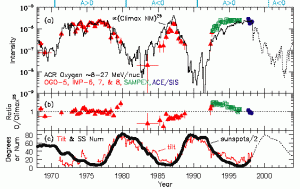Prediction of anomalous cosmic ray intensities near Earth
The figure illustrates many of the important features of the solar modulation of anomalous cosmic rays (ACRs) and also gives us a forecast for the coming years.
Panel (a) shows the intensity of ACR O at 1 AU as measured by a variety of observers over the last 30 years. The SAMPEX measurements are the green boxes.
Also shown is a curve proportional to the Climax neutron monitor rate (from the University of Chicago) raised to the 25th power. This curve was normalized in such a way that it is a close match to the ACR O observations during the period 1971-78 (see ratios in panel (b)). This period is contained within the so-called A>0 phase of the solar cycle (the phases are labeled at the top of the panel) during which the magnetic field of the Sun is directed outward at the north pole of the Sun and inward in the South. During this phase, positively charged particles gain access to the inner heliosphere via drift from the polar regions of the Sun.
This is in contrast to the A<0 period in which positive particles gain access to 1 AU via rapid drift along the Sun's neutral sheet. The tilt (LOS from Wilcox Solar Observatory) of the neutral sheet is shown in panel (c). Also shown in (c) is a curve proportional to the smoothed sunspot number (from the NGDC). The features to note are 1) the gradual decline in ACR O intensity during ~1978-84 versus the steep decline during ~1987-89 and 2) the overestimate of ACR O from the neutron monitor proxy in 1984-89 and the underestimate in 1992-95. We interpret the steep decline in fluxes that begins in 1987 as due to the increased tilt of the neutral sheet which immediately interrupts the "pipeline" of positive particles drifting inwards from the outer heliosphere. On the other hand, during the 1978-84 period, the particles are less sensitive to the tilt of neutral sheet since they are drifting into 1 AU from the Sun's polar regions. The modulation in this case is controlled more by propagating solar disturbances acting as modulating barriers. To become fully effective these barriers need to travel to the outer heliosphere. This takes some time and results in not only the gradual decline but the offset between the minimum ACR O intensity and the maximum in sunspot numbers. No such offset is present in the ~1990 solar maximum period. We interpret the excess ACR O flux from SAMPEX in 1992-95 as primarily due to the positive latitudinal gradient during this period, which is as much as 5%/deg based on Ulysses observations. (The latitudinal gradient of high energy protons is thought to be very small). The trend in the ACR O to Climax rate (b) follows the trend in the tilt of the neutral sheet which is roughly proportional to the heliomagnetic latitude (HML) of SAMPEX. The change in HML over the period, ~12 degrees, suggests that most of the discrepancy can be ascribed to this mechanism. By 1998, the HML of the Earth has become small and the ACR O intensity again matches that of the last A>0 period some 20 years earlier.
The low ACR O intensities in 1984-89 are also likely a latitude gradient effect. During this A<0 period the gradient is reversed in sign from the A>0 period, in agreement with the observations shown here.
Finally, this analysis suggests that the intensities in the coming years may mirror the behavior ~20 years ago. In panel (c) the dotted line shows the predicted sunspot numbers from the NGDC, which is very similar to the profile 20 years earlier. In panel (a), the dotted line shows the scaled Climax neutron monitor rate from 20 years earlier plotted into the future. We expect the ACR O intensities at 1 AU to roughly follow this line, suggesting the next solar maximum will occur in ~2002-03 at 1 AU and about a year later in the outer heliosphere at the location of the Voyager spacecraft.
Contributed by A. C. Cummings. R. A. Mewaldt, and E. C. Stone, Caltech
«Return to the Results page
